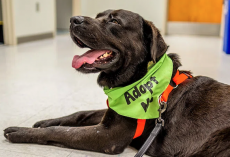Ever wondered whether dogs can get anxiety?
They definitely can — and knowing the signs is key to helping your pup feel safe and supported.
Just like humans, dogs can experience anxiety on a spectrum, from small signs of discomfort to more serious behaviors. Here are the most common signals to watch for, broken down from mild to severe.
Mild Anxiety Signs
These early clues often mean your dog is uncomfortable or unsure about what’s happening around her.
1. Lip-Licking
Dogs may lick their lips when they’re nervous or uncertain. If it’s happening outside of mealtime, it’s often an anxiety cue.
2. Excessive Yawning
Yawning doesn’t always mean fatigue. If your dog is yawning frequently at odd times of day, it may be her way of coping with stress.
3. Changes in Activity Levels
Both withdrawal and sudden bursts of hyperactivity can signal mild anxiety. If she’s keeping to herself or bouncing off the walls, she may be unsure how to handle her emotions.
Moderate Anxiety Signs
These symptoms suggest your dog is feeling more intensely stressed.
4. Tail Tucking
A tucked tail is a classic sign your dog feels uneasy or scared.
5. Flattened Ears
Pinned-back ears indicate your dog is feeling more overwhelmed or anxious.
Other moderate signs include:
- Elevated heart rate
- Faster breathing
- Dilated pupils
These physical changes usually accompany growing fear or discomfort.
Severe Anxiety Signs
These behaviors show your dog is extremely distressed and needs help right away.
6. Attempting to Escape
If your dog is scrambling to get away from a situation — pacing, bolting, clawing at doors — her anxiety may be intense.
7. Hiding
Retreating under furniture or seeking out dark, isolated spots can mean she feels terrified.
8. Aggressive Behavior
Growling, snapping or lunging often come from fear, not anger. Dogs in high anxiety mode may react aggressively because they feel cornered.
Other signs of severe anxiety include freezing completely or refusing to move.
How to Help a Dog With Anxiety
If you think your dog has anxiety, the best treatment plan depends on:
- The trigger (what’s causing the fear)
- How long it lasts
- How often it happens
- How intense the behavior is
For severe or frequent anxiety
Vets often recommend a combination of:
- Medication to reduce panic
- Environmental adjustments to limit exposure to triggers
- Behavior modification to help your dog build confidence in scary situations
For mild anxiety
Many dogs improve through:
- Desensitization (gradually exposing your dog to the trigger in controlled, low-stress ways)
- Confidence building with positive reinforcement
- Guidance from your vet or a certified trainer or behaviorist
At-Home Tools That May Help
You can also try calming aids to help calm down an anxious dog as you work on training:
These tools aren’t cures, but they can make your dog feel safer while you address the root cause.
If you think your dog may be dealing with anxiety, reach out to your veterinarian. Early support can make a huge difference in helping your pup feel calm, confident and secure again.
We independently pick all the products we recommend because we love them and think you will too. If you buy a product from a link on our site, we may earn a commission











